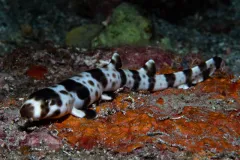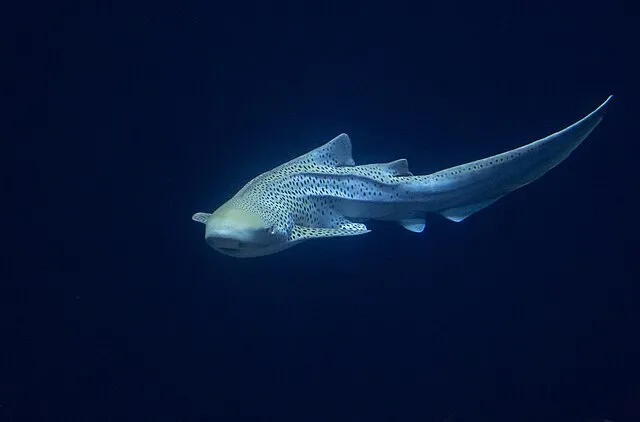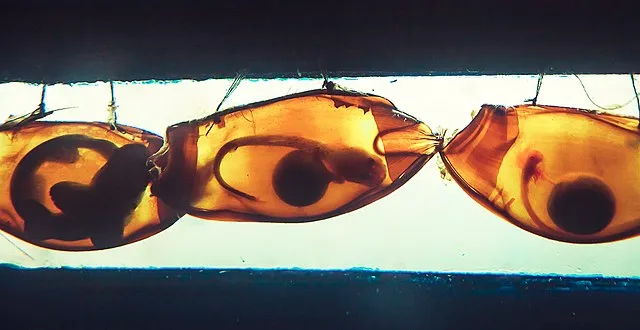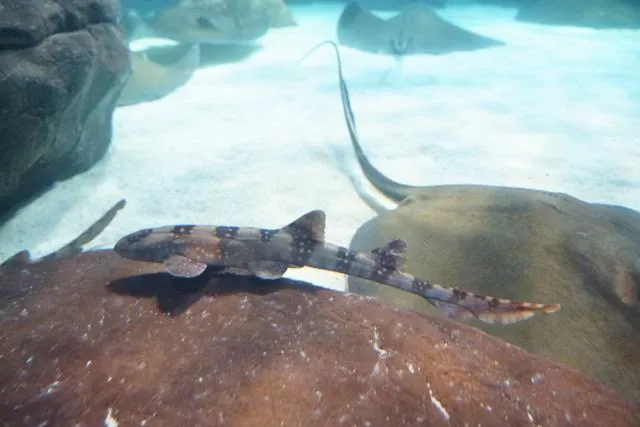Parthenogenesis: When Female Sharks Reproduce Without a Mate

On August 23, 2023, a shark seemingly appeared out of nowhere. Swimming along the aquarium’s sandy floor was a striped surprise. The three female epaulette sharks at the Brookfield Zoo in Illinois suddenly had a new roommate: a teeny-tiny, 15-centimeter baby shark.
The discovery of this newborn shocked the aquarium staff. None of the sharks had appeared to be pregnant. Furthermore, the mother of this new baby had not been housed with males since she was three years old and had yet to reach sexual maturity There was no way she could have mated with a male—so how did this young female become a mother all by herself?
This is a question that has stumped scientists for a while. Fish, snakes, lizards, and even birds have all been observed to be able to reproduce without fertilization—a phenomenon known as parthenogenesis.
Asexual reproduction, or the ability of a parent to clone itself to produce offspring, is common for many plants and invertebrates—for example, sea stars. In fact, it predates sexual reproduction, which evolved in order to introduce more genetic variation and allow for a quicker response to environmental change. Adaptability is almost always a good thing, which is why the organisms we are most familiar with today tend to exhibit sexual reproduction.
However, parthenogenesis is a different process. Eggs are developed during parthenogenesis, while in other methods of asexual reproduction they are not. Outside of plants and the microscopic world, this method was thought to be reserved for invertebrates—but repeated observations of vertebrates reproducing parthenogenetically have proved this to be untrue. Parthenogenesis has been seen occurring naturally in all vertebrate lineages except one: mammals.
Perhaps even more mind-boggling is that parthenogenesis isn’t even that rare. It has flown under the radar for decades, with scientists only observing it in animals in managed care. In aquariums, a newcomer—like the baby epaulette—is difficult not to notice, especially in an all-female tank.
“Parthenogenesis is one of those things we’re still trying to wrap our heads around. It’s very similar to cloning, and not always exactly the same—at least not genetically speaking—but the weird thing is that it’s starting to be obvious that parthenogenesis is really common,” says Dr. Toby Daly-Engel, a shark biologist and assistant professor at the Florida Institute of Technology.
Scientists still don’t know exactly why parthenogenesis happens. One hypothesis states that it is triggered by an absence of males, which is why our primary known examples are found in aquariums. But Dr. Daly-Engel thinks there may be more to the story: “Perhaps parthenogenesis is actually common in nature but we don’t have a chance to observe it,” she elaborates. Who knows how many sharks are reproducing parthenogenically in nature, underwater and far away from the eyes of researchers?
Dr. Jennifer Wyffels is a researcher at Ripley’s Aquariums and the University of Delaware, where she studies shark development. Like Dr. Daly-Engel, she’s no stranger to parthenogenesis. Her research project involving artificial insemination revealed something interesting: despite female sharks having access to sperm—whether through artificial insemination or the presence of a male—they sometimes still opted to reproduce parthenogenetically. These findings continue to reveal the complex nature of this phenomenon.
“I don’t think, in some cases, that reproduction is as simple as we like to think it is. Just having male and female sharks of the same species together doesn’t guarantee that a male will successfully breed a female,” said Dr. Wyffels. From genetic incompatibility and size differences between males and females to simply wrong timing (in the case of artificial insemination), there are plenty of reasons why reproduction might fail. Perhaps that’s when parthenogenesis comes into play.
However common parthenogenesis may be, it’s not a great reproductive strategy. Asexual reproduction is a good method for rapidly reproducing organisms, such as microbes or invertebrates, since they can essentially “outrun” natural selection. But for creatures like sharks, organisms with a long reproductive cycle and lifespan, it’s not a good way of increasing genetic diversity—something that could prove to be detrimental to the species as a whole.
To understand why parthenogenesis isn’t a favorable option, we need to first understand exactly how it occurs. When an egg is produced by meiosis (the type of cell division that produces haploid gametes, or cells with half of the organism’s genetic information), three small cells called polar bodies are also produced. Like the egg, these polar bodies contain half of the female’s genetic information.
“In a normal situation, the polar bodies are simply reabsorbed by the female. But in parthenogenesis, one of those polar bodies is essentially used to fertilize the egg,” describes Dr. Kevin Feldheim, a geneticist at the Field Museum in Chicago.
Understanding the ins and outs of parthenogenesis requires a basic understanding of genetics. In animals that reproduce via sexual reproduction, each parent supplies a copy of genes to the offspring. For example, in one of the genes for human eye color, one parent can supply a brown eye color copy and another a blue eye color copy. The more dominant copy (in this case brown eye color) becomes the gene expressed. Most offspring born via parthenogenesis carry two identical versions of all their genes; when a gene has two identical copies, scientists refer to the gene as homozygous. Interestingly, research has suggested that a specific polar body is used in most cases of parthenogenesis, one that maintains these patterns of homozygosity in offspring. So with each new generation of parthenotes (organisms born via parthenogenesis), the variety within genes in a population is reduced. With reduced variability comes reduced adaptability, rendering the species more susceptible to disease or environmental change.
Alongside the negative consequences across a population, parthenotes don’t have the best track record when it comes to survivorship or fitness. “For zebra sharks, parthenote embryos had a high rate of mortality after hatching and did not grow as fast or big as sexually produced embryos. None survived long enough to be able to reproduce themselves (around six years)—which is obviously not advantageous or good from a fitness perspective. So there are pretty significant consequences to being a parthenote. Another interesting finding from this research was that parthenotes had a high incidence of vertebral deformities, especially in the tail,” says Dr. Wyffels.
Despite the slew of challenges, there are some cases where parthenotes have gone on to survive and reproduce themselves. Interestingly, offspring viability seems to be on a species-by-species basis—bamboo sharks have been observed to have successful parthenotes while zebra sharks fail, for example.
“There seems to be really big differences between species, which is true about the reproductive system across the board for sharks, skates, and rays. They all have very specific reproductive modes and physiology. And, sure, there are some commonalities, but you shouldn’t make any assumptions just because you know something about one species that it’s going to work the same in another,” continues Dr. Wyffels.
Despite continuing research on the subject the question still stands: why do sharks exhibit parthenogenesis? The general consensus is that a chance of reproduction is reason enough for a shark to reproduce parthenogenetically—a small chance is better than none. But there’s undoubtedly much more to be discovered. For now, we can sit back and admire both the sharks and the researchers who are helping shed light on this incredible process.




